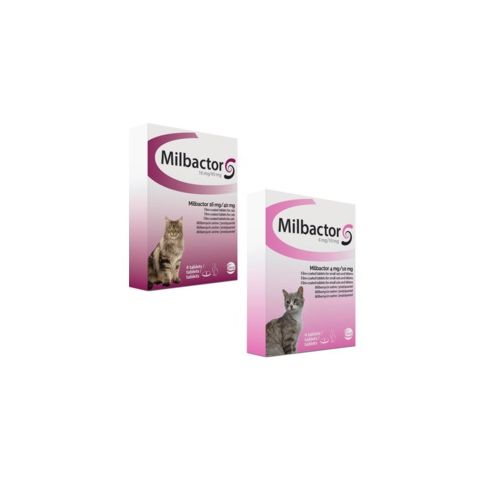Milbactor cat
Milbactor cat is unfortunately withdrawn from the market. The alternative to Milbactor cat, with the same active ingredients, is Milpro cat.
Milbactor cat
Milbactor deworming tablets for large cats (weighing at least 2 kg) are suitable for the prevention of heartworm and for the treatment of mixed infections caused by roundworms, hookworms, lungworms, and tapeworms. Additionally, Milbactor is also effective against eyeworms (known as Thelazia callipaeda).
Active Ingredients and Dosage
One 16 mg/40 mg Milbactor tablet for large cats contains:
Milbemycin oxime 16 mg
Praziquantel 40 mg
|
Dosage |
|
| Weight of the cat |
Recommended Dosage |
| 2 - 4 kg | 1/2 tablet |
| 4 - 8 kg | 1 tablet |
| 8 - 12 kg | 1 1/2 tablets |
One 4 mg/10 mg Milbactor tablet for small cats and kittens contains:
Milbemycin oxime 4 mg
Praziquantel 10 mg
|
Dosage |
|
| Weight of the cat | Recommended Dosage |
| 0.5 – 1 kg | 0.5 tablet – small cat and kitten |
| 1 – 2 kg | 1 tablet – small cat and kitten |
Milbemycin oxime is effective against roundworms, hookworms, whipworms, and can also be used for the prevention of heartworm. Praziquantel is effective in case of infestation with tapeworms, including the fox tapeworm.
Administration
Milbactor tablets should be administered orally only, either with or after food. It is recommended to deworm your cat at least 4 times a year, which is every 3 months.
How often should you worm a cat?
The ESCCAP (European Scientific Counsel Companion Animal Parasites) recommends deworming adult cats an average of 4 times a year. Kitten deworming at 3, 5 and 7 weeks of age, then every month until they are six months old.
Leaflet
For more information, please read the Milbactor leaflet.
Want to know more?
Learn more about deworming cats here!
 You earn (from) 210 PharmaPoints
You earn (from) 210 PharmaPoints
 Earn 100 PharmaPoints for writing a review for this product
Earn 100 PharmaPoints for writing a review for this productMilbactor cat is unfortunately withdrawn from the market. The alternative to Milbactor cat, with the same active ingredients, is Milpro cat.
Milbactor cat
Milbactor deworming tablets for large cats (weighing at least 2 kg) are suitable for the prevention of heartworm and for the treatment of mixed infections caused by roundworms, hookworms, lungworms, and tapeworms. Additionally, Milbactor is also effective against eyeworms (known as Thelazia callipaeda).
Active Ingredients and Dosage
One 16 mg/40 mg Milbactor tablet for large cats contains:
Milbemycin oxime 16 mg
Praziquantel 40 mg
|
Dosage |
|
| Weight of the cat |
Recommended Dosage |
| 2 - 4 kg | 1/2 tablet |
| 4 - 8 kg | 1 tablet |
| 8 - 12 kg | 1 1/2 tablets |
One 4 mg/10 mg Milbactor tablet for small cats and kittens contains:
Milbemycin oxime 4 mg
Praziquantel 10 mg
|
Dosage |
|
| Weight of the cat | Recommended Dosage |
| 0.5 – 1 kg | 0.5 tablet – small cat and kitten |
| 1 – 2 kg | 1 tablet – small cat and kitten |
Milbemycin oxime is effective against roundworms, hookworms, whipworms, and can also be used for the prevention of heartworm. Praziquantel is effective in case of infestation with tapeworms, including the fox tapeworm.
Administration
Milbactor tablets should be administered orally only, either with or after food. It is recommended to deworm your cat at least 4 times a year, which is every 3 months.
How often should you worm a cat?
The ESCCAP (European Scientific Counsel Companion Animal Parasites) recommends deworming adult cats an average of 4 times a year. Kitten deworming at 3, 5 and 7 weeks of age, then every month until they are six months old.
Leaflet
For more information, please read the Milbactor leaflet.
Want to know more?
Learn more about deworming cats here!
Use during pregnancy and lactation
Milbactor is suitable for pregnant and lactating cats
Adverse reactions
In rare case lethargy, neurological symptoms and gastro-intestinal symptoms can be observed.
| Animal | Cat, Kitten |
| Prescription required Netherlands | No |
| Prescription required Germany | Yes |
| Prescription required France | Yes |
| Prescription required Spain | Yes |
| Further information |

